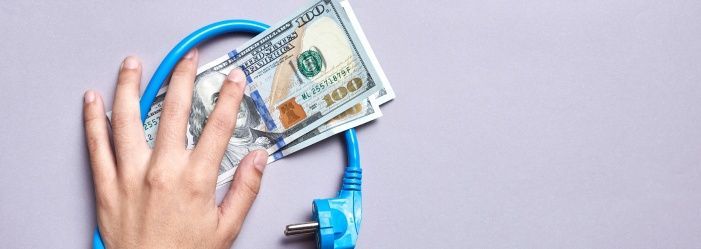Last Updated: March 14, 2024
Energy Costs Have Increased Each Year

Struggling with high electric bills? You're not alone. With the average U.S. household spending over $1,600 annually on electricity alone, finding ways to cut down on energy usage is more important than ever.
From quick fixes to long-term savings strategies, we've compiled a comprehensive guide to help you save money and reduce your environmental footprint.By adopting these energy-saving measures, not only will you see a decrease in your monthly bills, but you'll also contribute to a more sustainable and environmentally friendly lifestyle.
Let's dive into the top strategies for lowering your home energy bills, starting with a simple home energy audit.
If you'd rather speak to a debt specialist now, click here for a free consultation.
Increase Insulation
Most homes do not have enough insulation. Installing extra insulation in the attic will immediately lower both cooling and heating costs. It is relatively inexpensive, quick, and effective. Your next step is to insulate around windows, doors, and appliances, including garage doors. Blocking cold or hot air from leaking in around windows and doors and cold air out of refrigerators and freezers will save energy at a very low cost to you. Be cautious about insulating water heaters because it can void the warranty on newer water heaters and covering access panels and air flow to the water heater can cause fires.
Home Energy Rebates and Tax Credits
Making upgrades to improve your home's energy efficiency can save hundreds of dollars per year on utility bills. But the upfront costs may seem high. Luckily, you can offset upgrade expenses through home energy rebates, tax credits, and incentives offered on the federal, state, and local levels.
The federal government offers tax credits for installing qualified insulation, windows, doors, roofs, and HVAC systems. Many states and utilities provide additional rebates for the same upgrades. Some even offer credits for buying energy efficient appliances. The rebates and tax incentives can cover 5%-30% of your project costs.
Be sure to research what home energy incentives are available in your area before starting any upgrades. Our guide on [home energy tax credits and rebates](add URL) provides more details on how you can benefit.
Change Thermostats
Another quick and easy energy reduction is to adjust your thermometers. First, install a programmable thermostat for your HVAC unit and then moderate the temperature. Keep the house slightly cooler in the winter and slightly warmer in the summer. Dropping the temperature in the winter at night or while you are out for more than eight hours can lower energy costs by roughly 10%. Use fans to cool an area instead of turning down the energy sucking air conditioner.
Next, adjust your freezer and refrigerator temperatures. Set the fridge to 38*F and the freezer between 0 and 5*F. Your final step is to reduce your water heater temperature to 120*F. Not only will it save energy, but it is also safer for children and older people in your home.
Decrease Water Use
Lower energy bills by decreasing your hot water use. Take shorter, cooler showers and install a WaterSense labeled flow restrictor to decrease the amount of water you use. Wash clothes in cooler water. Not only will your clothes last longer but you save on water heating costs.
Change Your Lighting
Swap out regular bulbs for LED or fluorescent bulbs. The decreased energy use and longevity of the bulbs make up for the slightly higher prices. Occasionally, fluorescent bulbs can take a while to warm up and the light will be very dim for a few minutes. If you are using fluorescent bulbs outside, find ones that are rated for cold temperatures or use regular bulbs.
Installing dimmer switches can help. However, not all LED or fluorescent bulbs can handle being on a dimmer switch. If you are using both, make sure that it is a dimmer friendly bulb.
Turn off your exterior lighting when not in use. If you are concerned with security, use a motion activated light. Installing solar powered lights is also an effective energy saving action.
And finally, turn off the lights if you are not using them!
Stop Leaks
Next, check for leaks. We’ve already addressed leaks around windows, doors, and refrigerator/freezers. These next leaks are drippy faucets, chimney flues, and ductwork. Check your HVAC ducts for leaks and seal them. It may be worth hiring an expert to check your ductwork and tune up your HVAC system.
Repair leaky faucets (and toilets). Not only will you save on water costs, but if they are dripping hot water, you will save in energy costs.
Check for leaks around vents in bathrooms. You can lose a huge amount of heat through one of these, so make sure they are sealing properly.
Fireplaces are great. Chimneys are designed to move smoky air out of your house. Along with smoke, chimneys pull hot air out of your house. Always close the flue after the fire is out. Use a piece of plywood to block off the fireplace in the winter when the fire is out to decrease the loss of hot air. DO NOT close the flue or put a block in front of the fireplace when the fire is smoldering or the ashes are warm. The first leads to carbon monoxide build up in your house and the other to fires.
Completing a Home Energy Audit
One of the most effective ways to locate all energy leaks throughout a home is by having an energy audit performed by a certified professional. An energy auditor will complete a series of tests to measure air tightness, inspect insulation, check appliances, and more.
The auditor may perform blower door tests to precisely measure air leakage. They’ll also use an infrared camera to pinpoint drafts around windows, ducts, and other areas. Checking insulation levels in the walls, attic, floors, etc. is another key part of an energy audit. Finally, inspecting HVAC equipment, appliances, lighting, and electronics helps identify inefficient systems.
After completing their inspection, the auditor will provide a detailed report on your home’s energy efficiency. This includes recommendations for cost-effective upgrades prioritized by long-term energy savings potential. Upgrades may include adding insulation, sealing air leaks, replacing HVAC equipment, switching lighting, etc.
Home energy audits provide the blueprint for reducing utility bills through efficiency upgrades.
Buy Energy-Efficient Appliances
As you replace appliances, always choose the energy efficient ones as a replacement. The Energy Star label is a great place to start. For instance an Energy Star labeled dishwasher uses only 3.5 gallons of water, significantly decreasing heating costs and water usage. Since fridges, HVAC systems, water heaters, dehumidifiers, TVs, washers and dryers are run more often than any others, buying Energy Star models of these should be a priority.
Decrease Energy Trickles
Appliances that do not need to be plugged in (like your fridge) should be unplugged. This includes laptop plugs and cell phone chargers. Leaving them plugged in allows for a tiny trickle of power.
Another option for appliances like TVs and computers is to plug them into a smart power strip that completely turns off the power to the units when not in use.
And of course, turn off your computer, printer, etc when not in use!
Do Strategic Housekeeping
As you clean your house, vacuum off the coils behind the fridge to increase energy efficiency. Keep vents open and vacuums so that dust does not impede the air flow. Change air filters regularly - usually monthly. Clean windows to allow for more sunshine when it is cold. If it is hot, keep blinds and shades closed to keep the rooms cooler. Run your dishwasher when it is full instead of half full.
Try line drying clothes or towels if possible. Dryers suck a lot of energy. And try not to use the drying feature on the dishwasher. You may have to dry off some dishes, but the energy savings may be worth the extra time.
In The Kitchen
Kitchens are filled with heat producing, energy sucking appliances. Using these strategically can help decrease your energy use. First, thaw food before cooking it. Thawed food cooks faster and uses less heat. But don’t thaw in the microwave - these use a lot of energy!
Use heat producing appliances at night. Occasionally, energy costs are lower at night (off peak usage) and the heat generated will not make you want to turn down the AC.
Use the oven strategically. If it is hot outside, cook outside or eat cold foods. Preparing a roast on a hot day will make your AC work harder to keep the house cool. Try to use the oven in one go - don’t keep reheating the oven for each meal. A good quality airfryer can help decrease heating costs as they take far less time to cook foods.
Replace old metal cookware with glass or copper bottomed cookware as both conduct heat more effectively and quickly. You don’t have to do a wholesale unloading of your kitchen pots and pans - just when you are replacing them due to wear and tear. And while you are using the pots and pans, use lids as well. Lids decrease the cooking time and heat requirement (and keep your kitchen slightly cooler without the escaping steam).
More Expensive Energy Cost Cutting
Windows and doors are huge heat sinks. If you can afford it, replace windows with energy efficient ones. If you can’t, use the shrink wrap window plastic on windows that you don't open regularly. If exterior doors are not insulated, it is worth the cost to install them (or ask your landlord).
Ask your utility companies for an energy audit. They will have more suggestions on where you are losing energy and how to fix them.
Most of these steps are inexpensive and can be done easily by most adults. Tackling them over the span of a year will spread out the costs and lower home energy bills while you are at it. If you are having trouble paying your bills because you have overused credit cards, we can help.
FAQs
Pacific Debt, Inc
Pacific Debt, Inc is an award winning debt settlement company. If you’d like more information on how to get out of debt, we are happy to help. We will explain all your options and help you decide which is the best option for you. We can even refer you to trusted partners who can better meet your needs.
If you have more questions, contact one of our debt specialists today. The initial consultation is free, and our debt experts will explain your options to you.
✔ Accredited by Better Business Bureau with BBB A+ rating (4.93 rating and 1678 reviews)
✔ US News and World Reports and Bankrate ranked Pacific Debt Relief as one of “The Best Debt Relief Companies of 2024”
✔ 6.9 star rating by BestCompany.com (over 2379 client reviews)
✔ 4.8 star rating by TrustPilot based (over 1613 verified consumer reviews)
✔ ConsumerAffairs.com Accredited (over 544 verified reviews with an average rating of 5 stars)
✔ A Top 10 Rated Compan by TopTenReviews.com , ConsumersAdvocate.com and Top10debtconsolidation.com
✔ 4.6 star rating by Google (229 client reviews)
✔ 100% rating by SuperMoney (9 client reviews)
Reduce Your Credit Card Debt By Up to Half

BBB Reviews | 4.9/5.0 Rating









 Do Not Sell My Personal Information
Do Not Sell My Personal Information